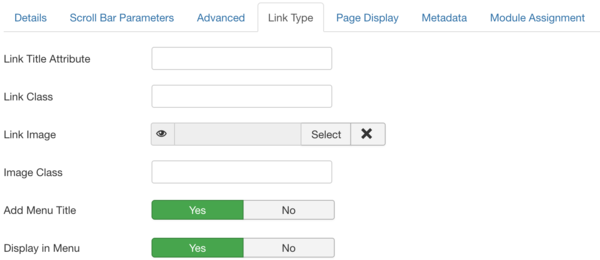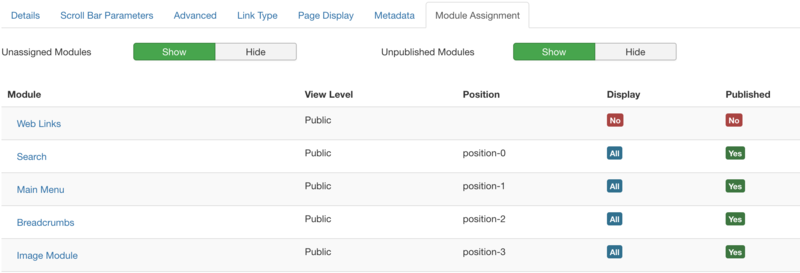Menus Menu Item Wrapper
From Joomla! Documentation
Description[edit]
Used to create a page with embedded content using an IFrame with control of iframe size, width and height.
How to Access[edit]
Add a new menu item 'Iframe Wrapper'
- Select Menus → [name of the menu] → Add New Menu Item from the dropdown menu of the Administrator Panel
- Select Wrapper → Iframe Wrapper in the modal popup window.
Edit an existing menu item 'Iframe Wrapper'
- Click on the menu item's Title in Menu items.
Screenshot[edit]
Form Fields[edit]
- Menu Title. The title that will display for this menu item.
- Alias. The internal name of the menu item. Normally, you can leave this blank and Joomla will fill in a default value. The default value is the Title in lower case and with dashes instead of spaces. You may enter the Alias manually. Learn more about Aliases.
Details[edit]
- Menu Item Type. The Menu Item Type selected when this menu item was created. This can be one of the core menu item types or a menu item type provided by an installed extension.
- URL. Field to enter a URL (web page address).Note: Generally, it is a good idea to always add http:// or https:// when providing a URL. There is a Auto add function to prefix a URL with http:// unless it detects the prefix in the URL. Note: Use the relative path to a web page address on Joomla installation. If your Joomla website is http://www.example.com, then use /html_docs/example.html omitting http://www.example.com and make sure the 'Auto add' function is disabled.
- Link. The system-generated link for this menu item. This field cannot be changed and is for information only.
- Target Window. This determines how the new page will be opened. Options are:
- Parent: Open new menu item in parent window. This is the default.
- New Window With Navigation: Open menu item in a new window with full browser navigation (for example, "back" button).
- New Without Navigation: Open menu item in a new window without browser navigation.
- Template Style. Controls the template style for this menu item. A list box will show the available template styles for your site.
- - Use Default -: Use the default style for the site to show this menu item.
- [Template Style]: Select a specific template style to always show this menu item with that style.
- Menu. Shows which menu the menu item will appear in.
- Parent Item. The parent menu item for this menu item. Used to determine whether a Menu Item is a top-level item or a submenu item.
- Menu Item Root: Select the default value if this is a top-level Menu Item.
- [menu item title]: Select the Menu Item that is this menu item's parent.
- Ordering. Indicates the order of this Menu Item in the Menu. The default Order is to add the Menu Item to the end of the Menu. This Menu Item will moved to the order position just after the Menu Item selected from the dropdown list. Note: The Order can also be changed in Menu Items.
- Status. (Published/Unpublished/Trashed) The published status of the menu item.
- Default Page. (Yes/No) If Yes, this menu item is the default or home page for the site. There must be exactly one menu item set as the default page. You can change the default page in 2 ways:
- Click on the Home column of the desired menu item in Menu Items.
- Open the menu item for the new default page and change the Default Page setting to Yes.
- Access. Who has access to this menu item.
- Public: Everyone has access.
- Guest: Everyone has access.
- Registered: Only registered users have access.
- Special: Only users with author status or higher have access.
- Super Users: Only super users have access.
- Language. Select the language for this menu item. If you are not using the multi-language feature of Joomla, keep the default of All.
- Note. Menu item note. This is normally for the site administrator's use (for example, to document information about this menu item) and does not show in the Frontend of the site.
Scroll Bar Parameters[edit]
- Scroll Bars. (No/Yes/Auto) Whether or not to include horizontal and vertical scroll bars, no or yes. Auto will add the scroll bars automatically when needed because of embedded page size.
- Width. Width of the IFrame Window. Enter in a number of pixels or enter in a percentage (%). For example, "550" means 550 pixels. "75%" means 75% of the page width.
- Height. Height of the IFrame Window. Enter in a number of pixels or enter in a percentage (%). For example, "550" means 550 pixels. "75%" means 75% of the page height.
Advanced[edit]
- Auto Height. (Yes/No) Automatically set height to height of external page. Note: This will only work if the external page is on the same domain. For example, http://www.example.com the external html must be in the example.com root file structure. Sub domains will not work, as a sub domain is considered a separate domain.
- Auto Add. (Yes/No) Automatically prefix web address with http://. This feature will automatically detect and not prefix a URL with http:// or https:// already used in the URL.
- Frame Border. (Yes/No) Show frame border which wrap the iframe.
Link Type[edit]
- Link Title Attribute. An optional, custom description for the title attribute of the menu hyperlink.
- Link Class. An optional class to apply to the menu hyperlink.
- Link Image. Select an image to use with 'Menu Title'. Use 'Add Menu Title' set to No to show just image.
- Image Class. The class which is added to the image (src tag).
- Add Menu Title. (Yes/No) If optional image is selected, shows a 'Menu Title' next to image.
- Display in Menu. (Yes/No) Select No if you want to exclude this menu item from displaying in the menu.Note: Any submenu items will also be hidden.
Page Display[edit]
- Browser Page Title. Optional text for the "Browser page title" element. If blank, a default value is used based on the Menu Item Title.
- Show Page Heading. (Use Global/Yes/No). Show or hide the Browser Page Title in the heading of the page (If no optional text entered - will default to value based on the Menu Item Title). The Page heading is usually displayed inside the H1 tag.
- Page Heading. Optional alternative text for the Page heading.
- Page Class. Optional CSS class to add to elements in this page. This allows CSS styling specific to this page.
Metadata[edit]
- Meta Description. An optional paragraph to be used as the description of the page in the HTML output. This will generally display in the results of search engines. If entered, this creates an HTML meta element with a name attribute of "description" and a content attribute equal to the entered text.
- Meta Keywords. Optional entry for keywords. Must be entered separated by commas (for example, "cats, dogs, pets") and may be entered in upper or lower case. (For example, "CATS" will match "cats" or "Cats").Learn more about Meta Keywords.
- Robots. The instructions for web "robots" that browse to this page.
- Use Global: Use the value from the Metadata Settings.
- index, follow: Index this page and follow the links on this page.
- noindex, follow: Do not index this page, but still follow the links on the page. For example, you might do this for a site map page where you want the links to be indexed but you don't want this page to show in search engines.
- index, nofollow: Index this page, but do not follow any links on the page. For example, you might want to do this for an events calendar, where you want the page to show in search engines but you do not want to index each event.
- noindex, nofollow: Do not index this page or follow any links on the page.
- Secure. Whether or not to use SSL and the Secure Site URL for this page.
- Off: Do not use SSL.
- On: Use SSL.
- Ignore: Ignore this setting and use the global setting for the site.
Module Assignment[edit]
- Unassigned Modules. (Show/Hide) Show or hide modules unassigned to this menu item.
- Unpublished Modules. (Show/Hide) Show or hide modules that are unpublished.
Toolbar[edit]
At the top left you will see the toolbar.
The functions are:
- Save. Saves the menu item and stays in the current screen.
- Save & Close. Saves the menu item and closes the current screen.
- Save & New. Saves the menu item and keeps the editing screen open and ready to create another menu item.
- Save as Copy. Saves your changes to a copy of the current menu item. Does not affect the current menu item.Note: This toolbar icon is only shown if you edit an existing menu item.
- Close. Closes the current screen and returns to the previous screen without saving any modifications you may have made.
- Help. Opens this help screen.







